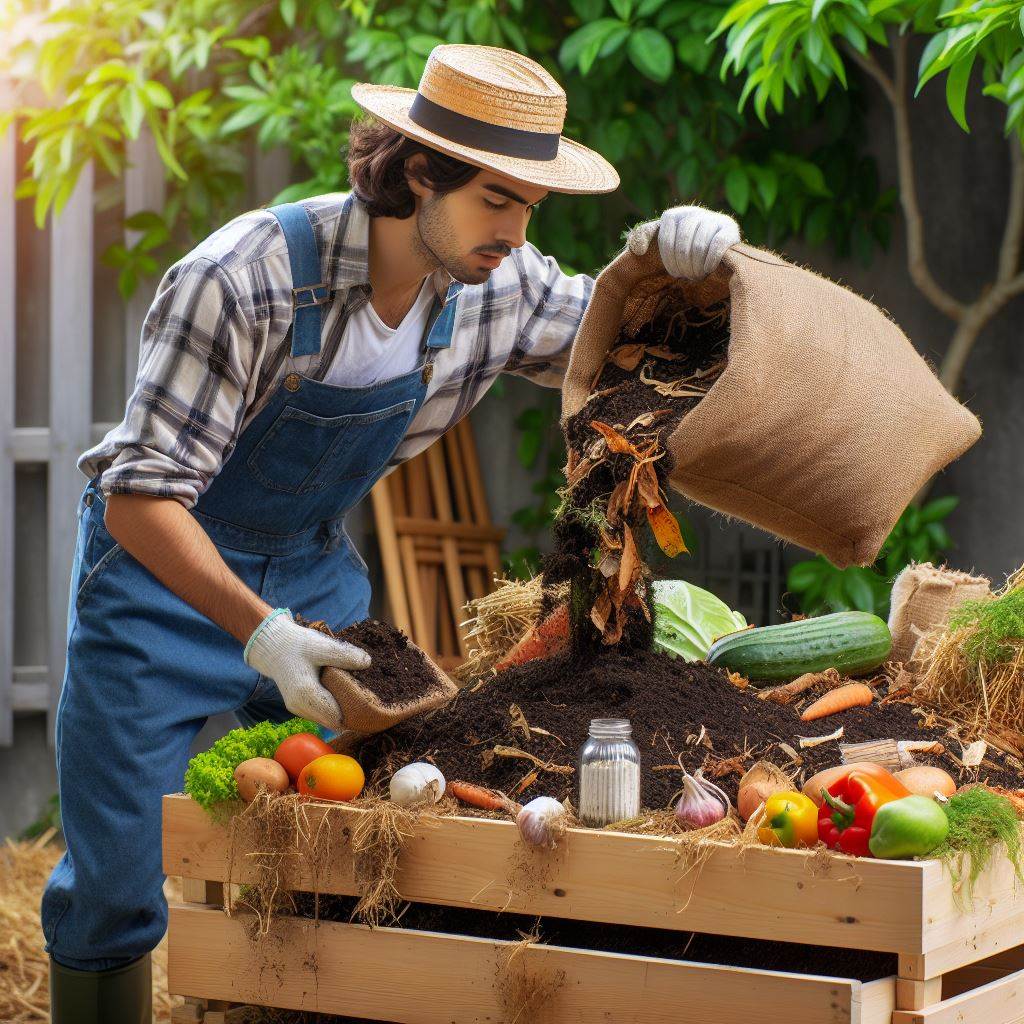Introduction
Balcony farming tips for city dwellers, a practice gaining traction among urbanites, involves cultivating plants in limited spaces such as balconies or rooftops.
City dwellers find balcony farming advantageous due to its ability to offer fresh herbs, fruits, and vegetables right at their doorstep, reducing reliance on store-bought produce.
Additionally, balcony farming contributes to environmental sustainability by promoting green spaces in concrete jungles and reducing carbon footprint associated with transportation of food.
Furthermore, tending to plants on a balcony can serve as a therapeutic activity, relieving stress and fostering a sense of connection with nature amid the hustle and bustle of city life.
The purpose of this blog post is to equip city residents with practical strategies and advice to make their balcony farming endeavors fruitful and enjoyable.
Through tips on plant selection, container gardening techniques, soil management, pest control, and maximizing sunlight exposure, readers will learn how to optimize their balcony space for successful cultivation.
With the right guidance and a little dedication, even those with limited outdoor areas can transform their balconies into thriving mini-gardens, reaping the rewards of homegrown produce and greener living.
Selecting the right plants
When it comes to balcony farming in a city setting, selecting the right plants is crucial for success.
Container gardening allows city dwellers to cultivate their own green space in limited areas.
Let’s explore the key factors to consider when choosing plants and discover some popular options for balcony farming.
Choose plants that are suitable for container gardening
- Consider the climate and balcony conditions: The first step in selecting the right plants is understanding the climate and conditions of your balcony. Assess factors like sunlight exposure, wind intensity, and temperature fluctuations. Different plants thrive in different environments, so it’s important to choose varieties that can adapt and flourish in your specific conditions.
- Opt for plants that don’t require too much space or root depth: Since balcony space is limited, prioritize plants that don’t demand a large area or extensive root systems. Look for compact and shallow-rooted varieties that can grow well in pots or containers. This way, you can maximize the use of your balcony space without compromising on the health and growth of your chosen plants.
Some popular plants for balcony farming
- Herbs like basil, mint, and parsley: Herbs are ideal for balcony farming as they are compact, low-maintenance, and provide a fresh and aromatic addition to your cooking. Basil, mint, and parsley are commonly grown herbs that thrive in containers. They require minimal space, regular watering, and moderate sunlight exposure.
- Leafy greens such as lettuce and spinach: Leafy greens are another great choice for balcony farming. Lettuce and spinach can be grown in smaller pots or even hanging baskets. They are quick-growing vegetables that can be harvested continuously, offering a continuous supply of fresh and nutritious greens for your meals.
- Compact vegetables like cherry tomatoes and peppers: If you have a slightly larger balcony space, consider growing compact vegetables like cherry tomatoes and peppers. These plants can be grown in larger containers or even hanging planters. Cherry tomatoes and peppers are prolific producers and can yield a bountiful harvest in a limited area.
By selecting plants that are suitable for container gardening, considering the climate and balcony conditions, and opting for popular choices like herbs, leafy greens, and compact vegetables, city dwellers can successfully embark on their balcony farming journey.
Enjoy the satisfaction of growing your own food and adding a touch of greenery to your urban dwelling.
Read: Composting Basics for Richer Soil
Preparing the balcony space
Assess the available space and sunlight exposure
Before starting your balcony farming journey, it’s crucial to assess the space you have available and the amount of sunlight it receives.
This will help you determine which plants will thrive in your balcony garden and ensure their proper growth.
Clear the area of clutter and debris
The next step in preparing your balcony for farming is clearing out any clutter or debris that may be present.
By removing unnecessary items, you’ll make more space for your plants and create a clean and welcoming environment for them.
Remove unnecessary items
Take a look at your balcony and identify any items that aren’t needed for your farming project.
These could include old furniture, broken pots, or any other items that are taking up valuable space.
Get rid of these items to make room for your plant containers and maximize the use of your balcony.
Clean the balcony thoroughly
Transform Your Agribusiness
Unlock your farm's potential with expert advice tailored to your needs. Get actionable steps that drive real results.
Get StartedOnce you’ve cleared away the clutter, it’s time to give your balcony a good cleaning.
Sweep or vacuum the floor, wipe down any surfaces, and remove any dirt or dust that may have accumulated.
A clean balcony will not only look better but also provide a healthier environment for your plants.
Ensure proper drainage
Proper drainage is essential for balcony farming to prevent waterlogging and root rot.
Follow these steps to ensure your plants have the right amount of drainage:
Choose appropriate containers with drainage holes
When selecting containers for your plants, make sure they have drainage holes at the bottom.
These holes allow excess water to drain out, preventing water from sitting at the bottom and potentially damaging the roots.
Plastic, ceramic, or terracotta pots with drainage holes are all suitable options.
Use saucers or trays to collect excess water
To avoid water dripping onto your balcony or neighbors below, place saucers or trays under your plant containers.
These will collect the excess water that drains out and prevent any mess or damage caused by water runoff.
Empty the saucers regularly to avoid stagnant water and ensure proper drainage for your plants.
By preparing your balcony space adequately, you’ll create an ideal environment for successful balcony farming.
Assessing space and sunlight, clearing clutter, and ensuring proper drainage are essential steps towards a thriving balcony garden.
Now that your space is ready, it’s time to move on to the next section: “
Selecting the Right Plants for Your Balcony Garden.”
Read: Sustainable Farming Tools & Practices
Soil and fertilizers
When it comes to balcony farming, one crucial aspect that city dwellers must pay attention to is soil quality.
Since there is limited space available for plants to grow, it becomes even more important to provide them with the right nutrients.
In this section, we will explore the significance of soil and fertilizers in balcony farming.
Select a suitable potting mix
- Opt for high-quality commercial mixes: Choosing a good quality potting mix is vital for the success of your balcony garden. Commercial mixes are specially formulated to provide the necessary nutrients for plant growth. They ensure a well-drained and aerated soil composition, which is essential for healthy plant roots.
- Consider adding organic amendments: To further enhance the nutrient content of your potting mix, you can consider adding organic amendments. Organic amendments such as compost or worm castings are rich in nutrients and improve soil fertility. They also contribute to better water retention and enhance microbial activity in the soil. Mixing them into the commercial potting mix will provide a suitable environment for plant roots to absorb nutrients efficiently.
The importance of regular fertilizing
- Highlight the need for balanced nutrients: Regular fertilizing is necessary to ensure that plants receive a balanced supply of essential nutrients. Balcony farming often requires a more intensive approach to fertilizing due to the limited access to natural soil nutrients. By providing a balanced nutrient supply, you can prevent nutrient deficiencies and promote healthy plant growth.
- Explain different options for fertilizers: There are two main options for fertilizers – organic and synthetic. Organic fertilizers are derived from natural sources and release nutrients slowly over time. They improve soil quality and contribute to long-term plant health. Synthetic fertilizers, on the other hand, are chemically manufactured and provide an immediate nutrient boost. They can be convenient for quick nutrient supplementation, but excessive use can lead to nutrient imbalances and harm beneficial soil organisms.
In general, selecting a suitable potting mix and implementing regular fertilizing practices are crucial elements of successful balcony farming.
By opting for high-quality commercial mixes and incorporating organic amendments, you can ensure that your plants receive the necessary nutrients for healthy growth.
It is also important to choose the right type of fertilizer and maintain a balanced nutrient supply for optimal plant development.
By focusing on soil and fertilizers, city dwellers can maximize the potential of their balcony gardens and enjoy the benefits of homegrown produce.
Read: Must-Have Tools for Fruit & Veggie Gardens

Watering and maintenance
The importance of consistent watering
Consistent watering is crucial for successful balcony farming as it ensures proper growth and development of plants.
- Avoid overwatering or underwatering: Overwatering can lead to root rot and other fungal diseases. Underwatering can cause plants to wither and die.
- Tips for checking soil moisture levels: Regularly check the moisture level of the soil by inserting your finger about an inch deep into the soil. If it feels dry, it’s time to water the plants.
Common pests and diseases in balcony farming
Pests and diseases can significantly impact the health of your balcony garden.
Understanding them is essential for proper prevention and control.
- Identify common pests and their prevention/control measures: Some common pests in balcony farming include aphids, mealybugs, and spider mites. Use organic insecticides or introduce beneficial insects to control them.
- Mention natural remedies or integrated pest management strategies: Instead of using chemical pesticides, opt for natural remedies like neem oil or garlic spray. Integrated pest management combines multiple approaches to control pests effectively.
Tips for regular maintenance
Maintaining a balcony garden involves regular tasks to keep your plants healthy and thriving.
- Pruning and trimming plants: Prune or trim your plants regularly to promote bushier growth and prevent them from becoming leggy or overcrowded.
- Regularly inspecting and addressing plant health issues: Regularly inspect your plants for any signs of diseases or nutrient deficiencies. Address these issues promptly to prevent further damage to your crops.
Read: Garden Tool Safety: What You Need to Know
Showcase Your Farming Business
Publish your professional farming services profile on our blog for a one-time fee of $200 and reach a dedicated audience of farmers and agribusiness owners.
Publish Your ProfileHarvesting and enjoying the produce
Guide readers on when and how to harvest different plants
Harvesting the produce from your balcony garden is an exciting and rewarding experience.
It’s essential to know when and how to harvest different plants to maximize their flavor and nutritional value.
When it comes to leafy greens like lettuce and spinach, you can start harvesting individual leaves when they reach a desirable size.
Take care not to remove too many leaves at once, as this can shock the plant and hinder further growth.
Instead, opt for the “cut and come again” method, where you cut the outer leaves and allow the inner ones to keep growing.
For herbs, such as basil and mint, the best time to harvest is when the plants have developed full and aromatic leaves.
Simply snip off the stems just above a set of healthy leaves, which will encourage the plant to branch out and continue growing.
Root vegetables, like carrots and radishes, are ready for harvest when their tops start to push through the soil.
Gently loosen the soil around the plant and lift it out with care to avoid damaging the roots.
The benefits of homegrown produce
One of the significant advantages of balcony farming is the ability to enjoy homegrown produce.
Here are a few reasons why it’s worth the effort:
- Freshness and flavorful taste: Nothing beats the taste of freshly harvested fruits, vegetables, and herbs. Homegrown produce is packed with nutrients and often tastes better than store-bought varieties.
- Cost-effective and environmentally friendly: Growing your own food can save you money in the long run. Instead of buying expensive organic produce, you can grow it yourself without the use of harmful pesticides or chemicals. It’s a sustainable and eco-friendly way to feed yourself and your family.
Encouragement to experiment with recipes and share their experiences
Once you’ve harvested your homegrown bounty, it’s time to get creative in the kitchen.
Don’t be afraid to try new recipes and experiment with different flavors.
Here are a few ideas to get you started:
- Make a fresh salad using your homegrown lettuce, spinach, and herbs. Add some sliced tomatoes, cucumbers, and a homemade dressing for a delicious and healthy meal.
- Use your harvested herbs, like basil or rosemary, to make infused oils or flavored vinegars. These can be used in marinades, dressings, or to add extra flavor to roasted vegetables.
- Blend your homegrown fruits into smoothies or use them in homemade jams and jellies. The possibilities are endless.
Share your experiences with balcony farming and the recipes you’ve tried with friends, family, and online communities.
Engage in conversations, exchange tips, and inspire others to embark on their own balcony farming journey.
By harvesting and enjoying the produce from your balcony farm, you not only get to savor the flavors of your hard work but also reap the numerous benefits of homegrown food.
So, roll up your sleeves, put on your gardening gloves, and start growing your own delicious and nutritious crops right at home!
Conclusion
Balcony farming is a practical and rewarding way for city dwellers to grow their own food.
We discussed various tips, such as selecting suitable containers, choosing appropriate seeds, and providing adequate sunlight and water.
By utilizing their balconies, city dwellers can effectively utilize the limited space they have and cultivate their own fruits, vegetables, and herbs.
Moreover, balcony farming ensures access to fresh and healthy produce, promoting a sustainable and eco-friendly lifestyle.
Additionally, the act of nurturing plants and witnessing their growth can provide a sense of fulfillment and satisfaction.
So, for all city dwellers out there, why not start your own balcony farm and experience the joy of harvesting your own homegrown food?
It’s time to reconnect with nature and embrace the benefits of balcony farming.




